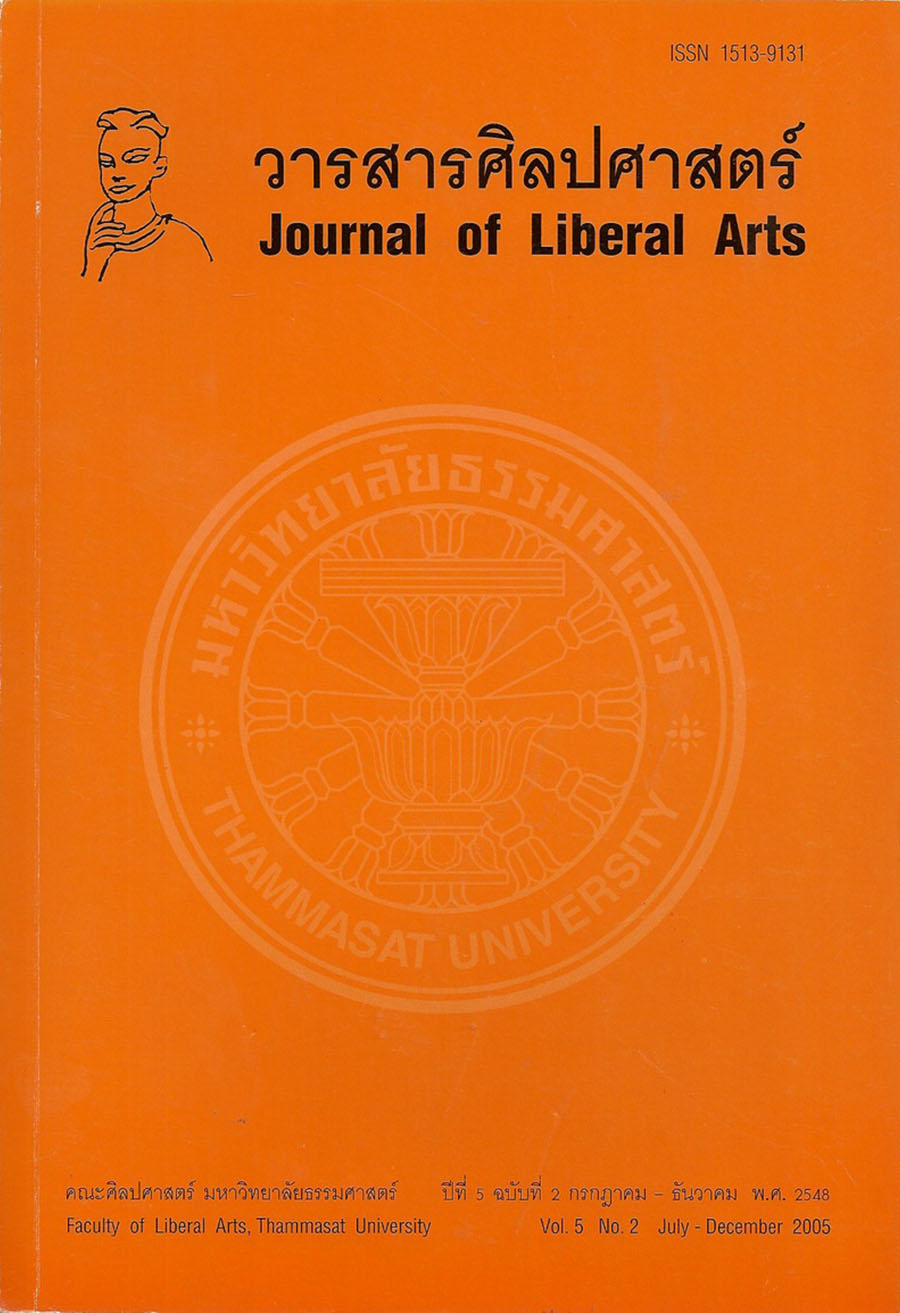การศึกษาแนวความคิดลัทธิขงจื้อแนวใหม่ในสมัยเอโดะที่ปรากฎในเรื่องนันโซซาโตมิฮัคเคนเด็นของเคียะคุเท บะคิน
Main Article Content
บทคัดย่อ
บทความนี้มีจุดมุ่งหมายเพื่อที่จะศึกษางานเขียนประเภทโยมิฮง (Reading book) ซึ่งจัดเป็นประเภทของนวนิยายชนิดหนึ่งที่ได้รับความนิยมในสมัยเอโดะ โดยจะหยิบยกเรื่องนันโซซาโตมิฮัคเคนเด็นขึ้นมาศึกษา ผู้แต่งเรื่องนันโซซาโตมิฮัคเคนเด็น (Satomi and the Eight Dogs) คือเคียะคุเท บะคินเป็นเรื่องราวกล่าวถึงการสู้รบแนวแฟนตาซี เพื่อช่วยเหลือตระกูลซาโตมิโดยเหล่าผู้กล้าทั้งแปดที่มีลูกแก้ววิเศษติดตัว โดยผู้กล้าทั้งแปดต่างมีคุณธรรมต่างกันไปตามตัวอักษรที่จารึกไว้บนลูกแก้ว กล่าวกันว่าเรื่องนี้ได้สอดแทรกแนวความคิดหลักที่เรียกว่า คันเซนโจอะคุ (Kanzenchōaku) ซึ่งหมายถึงการส่งเสริมให้ทำความดี และลงโทษความชั่ว แต่เมื่อศึกษาลึกลงไปแล้วจะพบว่าแนวความคิดหลักที่ผู้เขียนมุ่งเน้นและนำเสนอออกมาอย่างชัดเจนนั้นมีอีกสองประการนั่นก็คือแนวความคิดเรื่องของความกตัญญู และความภักดี สองแนวความคิดนี้ได้มีความเชื่อมโยงกับแนวความคิดของลัทธิขงจื้อแนวใหม่ที่ได้รับความนิยมกันอย่างแพร่หลายในสมัยเอโดะเป็นอย่างมาก กล่าวคือ ลัทธิขงจื้อแนวใหม่นั้นมุ่งเน้นในเรื่องของการให้ความสำคัญกับเรื่องลำดับชั้น โดยสนับสนุนในเรื่องความสัมพันธ์ของคนในระบบสังคม และให้ความสำคัญกับคติธรรมในเรื่องของความกตัญญูต่อบิดามารดา ความกตัญญูของข้ารับใช้ต่อเจ้านายและความภักดี ทั้งสองแนวคิดนี้ถือเป็นพื้นฐานสำคัญของจริยธรรมในระบบศักดินา และเป็นเครื่องมือของรัฐบาลทหารของโตกุกาว่า เพื่อเอื้อให้สามารถดูแลและปกครองหัวเมืองย่อยต่าง ๆ และรักษาความเป็นระเบียบเรียบร้อยของสังคมเอาไว้ได้ แต่ในอีกด้านหนึ่งอาจกล่าวได้ว่ารัฐบาลของโชกุนได้ใช้โยมิงฮง เพื่อเป็นการตอกย้ำถึงความยิ่งใหญ่ของอำนาจของตน ซึ่งนับวันจะเริ่มหมดบทบาทลงไปทุกที อันเป็นผลสืบเนื่องมาจากการขึ้นมามีอำนาจของชนชั้นกลุ่มใหม่นั่นก็คือชนชั้นพ่อค้าซึ่งกุมอำนาจทางเศรษฐกิจในสมัยเอโดะก็เป็นได้
The study of Neo-Confucianism in Kyokutei bakin’s Nansōsatomihakkenden aims to examine the Yomihon (Reading book) which is one of the famous genres of novels in the Edo period. Nansōsatomihakkenden (Satomi and the Eight Dogs) is a fantasy story telling about the war of Satomi House and their eight warriors who have eight special balls with them. These eight balls have an ideogram written on each and also represent the eight virtues. It is said that this story wants to teach us about the Kanzenchōaku concept which means admiring virtue and punishing vice. But if we study further, we will find that in this story the concept of filial piety and loyalty are also emphasized strongly and clearly. These two concepts of virtue are among the fundamental morals in Neo-Confucianism. Neo-Confucianism is an important philosophy in the Edo period: not only was it famous among scholars, but Shogun Ieyasu himself also urged his people to learn about it. Neo-Confucianism still emphasized the role of the individual as a functionary of society and had a system called “The Five Confucian Relationships” which divided people into four classes. Besides this, Neo-Confucianism also stressed the virtues of filial piety and the servant’s loyalty to his master. These two concepts were the most important elements in feudal society and allowed the shoguns to govern their country peacefully and orderly without opposition from any of the daimyos. On the other hand, we can see that the shogunate government also used the Yomihon to emphasize their power for fear that one day their influence would be replaced by the merchants, the new class whose authority was rising little by little and had more economical power than them.


